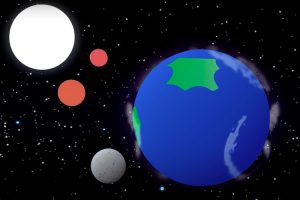The climate and habitability of planets with etern...
The new research investigates the climate states of rocky planets of Earth and Super-Earth-sizes with stable d...
‘Tropical cyclones’ is the meteorological term that encompasses hurricanes and typhoons; in the Indian Ocean, they’re called ‘cyclones’, but they’re all exactly the same physics. So, we use the phrase ‘tropical cyclones’ to mean that we’re talking about all of them, irrespective of where they are. I did a fair bit of research in the United States, and now I’m over here in Europe, and the ones in the Atlantic I referred to as ‘hurricanes’. ‘Hurricanes’ is a fairly common term.
So, a tropical cyclone is a very strong wind system. What we’re used to here, in London and in the northern hemisphere, is weather systems that are low-pressure systems. The air will try and move from a high pressure to a low pressure, and as it moves in, the Earth is spinning, and so it will get deflected by what’s referred to as the Coriolis effect. It’s sometimes called a force: it’s not really a force, but it’s a virtual one, and we can treat it as if it is a force. As that air is moving into the centre of the low-pressure system, it’s going to get deflected, and as it gets deflected, it’s going to spin round, so you end up with these spinning vortices.
So you get these very strong weather systems, and they’re formed, in some respects, through the same process that forms, say, the wider tropical circulation. You get warm water, and above that warm water, there’s warm air, and unsurprisingly, the warm air rises, so you get these big walls of convection, and that warm air rises, and then it slowly moves away and sinks. As it sinks, it cools, and as you get the air rising and the air sinking, there must be a return flow. It’s that return flow on the surface that’s being deflected and spun. So you get these sorts of convection cells.
You need just the right conditions to form this convection cell. The air’s got to go up, and then there needs to be enough wind aloft at the top of the atmosphere, which blows the sinking air so that it doesn’t fall on the same place as the rising air because otherwise, that would stop it. But if there’s too much wind, then that sinking air is moved so far away that it never quite reaches back. So there’s sort of a Goldilocks zone of needing the right wind shear attached to these convection cells. These convection cells form, and then they start spinning, and you end up with a pattern that is a centre with really strong convection, and then, much further out, you get this weaker inflow. But as it spins, it takes up a natural form of an eye and a wall. So rather than it being just a central bit, there’s a wall, and then you’ve got this section, this portion in the middle, which is referred to as the eye of the storm, which is very calm and has no convection. Invariably, you’ll have two rain bands. So, as it’s spinning, those inflowing jets will coalesce into two different rain bands.
So you get this very fast spinning storm, and these storms are associated with some of the fastest winds in the world and, therefore, are quite devastating. Thankfully, they don’t necessarily occur that often.
On average there’s about 90 tropical cyclones across the world in the course of a year, and each tropical cyclone will last a couple of days, that’s its maximum strength.
So there will often only be one around at once, or maybe a couple. So these things are very rare, but they’re very extreme. They need to be formed over the ocean because they’re sort of feeding off the energy that’s stored in the warm upper layer of the ocean; that’s what’s giving them their intensity. As they move around, if they go over the land, not only will that be a really bad thing because they’re going over the land and there’s much more likely to be people living in the land than living in the sea, but it cuts them off from their power source, so they start slowly decaying away.
The biggest concentration of tropical cyclones is in the Western North Pacific, and then you get some storms that form right in the Eastern North Pacific, right by Central America. You also get some storms that are formed in the Indian Ocean, mainly around the Bay of Bengal between Thailand and India itself, and you do get the odd few that are formed on the other side of India between India and Arabia and Africa. They’re rare, but when they happen, they can be quite devastating because they’re rare, so people don’t necessarily think so much about them and prepare for them. There’s some in the Atlantic as well: not so much on the African side of the Atlantic, more on the Caribbean. Partly that’s formation, but partly that’s also the way these storms go: in the tropics, they will head off towards the east and then, if they don’t hit land, they’ll start recurving as they move slowly north and then shoot off towards the west when they reach the mid-latitudes. So you get this sort of curving pattern, so you naturally will get more storms in the West Atlantic as they sort of coalesce.
There are two ways we can know that. One is we can look at things in the general background climate that are associated with storm formation. In the present climate, the 26-degree isotherm in the Atlantic is roughly where storms form, so that’s when it’s warmer than 26℃. But when we move into a warmer climate or a much-changed climate, then we’ll lose that direct link, so you need to look at more complex meteorological phenomena to tie things. But you can still tie things from the large-scale to these small-scale storms. The other way to do it is to do a really high-resolution climate model, and with that really high-resolution climate model, it can do things that are like tropical cyclones. Even a high-resolution climate model won’t have the ability to resolve the really devastating strong storms, but nonetheless, you can get something that, you can tell, is the model trying to do a hurricane, and so you can see what happens to that and follow those tracks. But doing those high-resolution climate models is an awful lot of work, and they produce an awful lot of data to follow.
So we’re at the point where we know that the conditions for the formation of storms are going to get slightly less favourable, but when those storms come, they are going to be slightly stronger. The thing we’re not so sure about is whether there’s going to be any changes in where the storms go and, therefore, what landfall might happen. Maybe all the storms will move slightly further north as the tropics warm, and that would change the risk of places.
We know there is a threat from these storms, and we know that the threat will change slightly because the storms are going to change slightly under climate change. We worry about that, but it’s something we can measure; that’s not necessarily the biggest issue with looking at the risk of tropical cyclones moving forward. The other thing that is one of the big threats from a tropical cyclone is that it pushes a lot of water in front of it, and as it pushes water in front of it, that might go overland. Clearly, if you have higher sea levels, then there’s more water that can be pushed inland.
Storm surge flooding is a real risk, and we would expect that to go up as the sea levels rise. Irrespective of quite how traffic of cyclones change, that becomes more of a threat.
Tropical cyclones have caused vast amounts of economic damage and loss of life, and building stuff in the way of a hurricane, especially if you don’t prepare for the fact that there might be a hurricane coming to hit it; it’s really what’s going to cause the problem. We do not necessarily we can have an idea of what the threats are going to do in the future, but really, the way we want to deal with that is to reduce our exposure to what these tropical cyclones will do in the future and be prepared that there is a risk of tropical cyclones, maintain building standards and don’t build things in obvious floodplains and things like that. So the response to tropical cyclones is an emergency response when you have a few days’ notice from weather forecasts getting out the way of it, and on the longer climate timescales, you’re really looking at responses that are preparedness and reducing the exposure to these storms. These storms will occur in future, and there is a link to climate change, but that’s awkward to measure and hard to measure. It’s there, but it’s something we must be aware of and prepare for.

The new research investigates the climate states of rocky planets of Earth and Super-Earth-sizes with stable d...

Mathematician Gareth Jones on number theory, why there are infinitely many of prime numbers and how to calcula...

Historian Alessandro Scafi on the garden of Eden, Augustin's concept of creation, and the emergence of the ter...